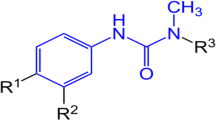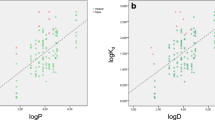Abstract
Forty pesticides were selected in function of their chemical families and their physico-chemical properties to represent a wide range of pesticide properties. Adsorption of these pesticides was studied on two soils by batch experiments. The two soils differed largely in organic matter and calcite contents. Distribution coefficient K d was determined for each pesticide on the two soils. Adsorption was higher for the soil having the highest organic matter content and the lowest calcite content. In order to identify pesticide properties governing retention, eight molecular descriptors were determined from three-dimensional (3D) structure of molecules. Class-specific quantitative structure properties relationship (QSPR) soil adsorption models using one and two parameters were developed from experimental K d. Three properties seemed to influence most retention of pesticides: hydrophobicity, solubility, and polarisability. Models combining these properties were suggested and discussed.





Similar content being viewed by others
References
Baker JR, Mihelcic JR, Sabljic A (2001) Reliable QSAR for estimating K oc for persistent organic pollutants: correlation with molecular connectivity indices. Chemosphere 45:213–221
Barber JL, Sweetman AJ, Wijk DV, Jones KC (2005) Hexachlorobenzene in the global environment: emissions, levels, distribution, trends and processes. Sci Total Environ 349:1–44
Bedos C, Génermont S, Le Cadre E, Garcia L, Barriuso E, Cellier P (2009) Modelling pesticide volatilization after soil application using the mechanistic model Volt’Air. Atmos Environ 43:3630–3639
Bin L, Fangang Z, Weifang M, Qichun D, Haitao F, Chuanfeng D (2012) Determination method of organophosphorus pesticide residues in fishs by GPC-GC-PFPD. Appl Mech Mater 138:1002–1006
Blondel A, Langeron J, Sayen S, Hénon E, Couderchet M, Guillon E (2013) Molecular properties affecting the adsorption coefficient of phenylurea herbicides. Environ Sci Pollut Res 20:6266–6281
Calvet R (1989) Adsorption of organic chemicals in soils. Environ Health Perspect 83:145–177
Cossi M, Scalmani G, Rega N, Barone V (2002) New developments in the polarizable continuum model for quantum mechanical and classical calculations on molecules in solution. J Chem Phys 117:43–54
Delle Site A (2001) Factors affecting sorption of organic compounds in natural sorbent/water systems and sorption coefficients for selected pollutants. A review. J Phys Chem 30:187–439
El Arfaoui A, Sayen S, Marceau E, Stievano L, Guillon E, Couderchet M (2009) Relationship between soil composition and retention capacity of terbumeton onto chalky soils. Environ Chem 6:245–252
El Arfaoui A, Sayen S, Paris M, Keziou A, Couderchet M, Guillon E (2012) Is organic matter alone sufficient to predict isoproturon sorption in calcareous soils? Sci Total Environ 432:251–256
Frisch MJ, Trucks GW, Schlegel HB, Scuseria GE, Robb MA, Cheeseman JR, Scalmani G, Barone V, Mennucci B, Petersson G.A, Nakatsuji H, Caricato M, Li X, Hratchian HP, Izmaylov AF, Bloino J, Zheng G., Sonnenberg JL, Hada M, Ehara M, Toyota K, Fukuda R, Hasegawa J, Ishida M, Nakajima T, Honda Y, Kitao O, Nakai H, Vreven T, Montgomery JJA, Peralta JE, Ogliaro F, Bearpark M, Heyd JJ, Brothers E, Kudin KN, Staroverov VN, Kobayashi R, Normand J, Raghavachari K, Rendell A, Burant JC, Iyengar SS, Tomasi J, Cossi M, Rega, N, Millam NJ, Klene M, Knox JE, Cross JB, Bakken V, Adamo C, Jaramillo J, Gomperts R, Stratmann RE, Yazyev O, Austin AJ, Cammi R, Pomelli C, Ochterski JW, Martin R L, Morokuma K, Zakrzewski VG, Voth GA, Salvador P, Dannenberg JJ, Dapprich S, Daniels A D, Farkas Ö, Foresman JB, Ortiz JV, Cioslowski J, Fox DJ (2009) Gaussian 09, Revision A.02 Gaussian. Wallingford, CT
Gaultier J, Farenhorst A, Crow G (2006) Spatial variability of soil properties and 2,4 D sorption in a hummocky field as affected by landscape position and soil depth. Can J Soil Sci 86:89–95
Gawlik BM, Sotiriou N, Feicht EA, Schulte-Hostede S, Kettrup A (1997) Alternative for the determination of the soil adsorption coefficient, K oc, of non-ionic organic compounds — a review. Chemosphere 34:2525–2551
Gramatica P, Corradi M, Consonni V (2000) Modelling and prediction of soil sorption coefficients of non-ionic organic pesticides by molecular descriptors. Chemosphere 41:763–777
Guzzella L, Capri E, Di Corcia A, Barra Caracciolo A, Giuliano G (2006) Fate of diuron and linuron in a field lysimeter experiment. J Environ Qual 35:312–323
Hussein S, Devers-Lamrani M, El Azhari N, Martin-Laurent F (2011) Isolation and characterization of isoproturon mineralizing Sphingomonas sp. strain SH from a French agricultural soil. Biodegradation 22:637–650
Huuskonen J (2003) Prediction of soil sorption coefficient of a diverse set of organic chemicals from molecular structure. J Chem Inf Comput Sci 43:1457–1462
Irace-Guigand S, Aaron JJ (2003) The role of organic colloids in herbicide transfer to rivers: a quantitative study of triazine and phenylurea interactions with colloids. Anal Bioanal Chem 376:431–435
Marenich AV, Cramer CJ, Truhlar DG (2009) Universal solvatation model based on solute electron density and a continuum model of the solvent defined by the bulk dielectric constant and atomic surface tensions. J Phys Chem B 113:6378–6396
Messing PG, Farenhorst A, Waite DT, McQueen DAR, Sproull JF, Humphries DA, Thompson LL (2011) Predicting wetland contamination from atmospheric deposition measurements of pesticides in the Canadian Prairie Pothole Region. Atmos Environ 45:7227–7234
Miertus S, Scrocco E, Tomasi J (1981) Electrostatic interaction of a solute with a continuum. A direct utilization of ab initio molecular potentials for the prevision of solvent effects. Chem Phys 55:117–129
Morvan X, Mouvet C, Baran N, Gutierrez A (2006) Pesticides in the groundwater of a spring draining a sandy aquifer: temporal variability of concentrations and fluxes. J Contam Hydrol 87:176–190
Palma G, Sanchez A, Olave Y, Encina F, Palma R, Barra R (2004) Pesticide levels in surface waters in an agricultural-forestry basin in Southern Chile. Chemosphere 57:763–770
Park JS, Shin SK, Kim WI, Kim BH (2011) Residual levels and identify possible sources of organochlorine pesticides in Korea atmosphere. Atmos Environ 45:7496–7502
PPDB (2009) The Pesticide Properties Database (PPDB) developed by the Agriculture & Environment Research Unit (AERU), University of Hertfordshire, Funded by UK national sources and the EU-funded FOOTPRINT project (FP6-SSP-022704)
Scalmani G, Frisch MJ (2010) Continuous surface charge polarizable continuum models of solvation: I. General formalism. J Chem Phys 132:114110/1-114110/15
Schaftenaar G, Noordik JH (2000) Molden: a pre- and post-processing program for molecular and electronic structure. J Comput Aided Mol Des 14:123–134
Tomasi J, Mennucci B, Cammi R (2005) Quantum mechanical continuum solvation models. Chem Rev 105:2999–3093
Turgut C, Atatanir LT, Cutright J (2010) Evaluation of pesticide contamination in Dilek National Park, Turkey. Environ Monit Assess 170:671–679
Zhao Y, Truhlar D (2008) The M06 suite of density functionals for main group thermochemistry, thermochemicak kinetics, noncovalent interactions, excited states, and transition elements: two new functionals and systematic testing of four M06-class functionals and 12 other functional. Theor Chem Accounts 120:215–241
Acknowledgments
This research is part of the AQUAL CPER Program. It was financed by the ‘Conseil Général de la Marne’, the Champagne-Ardenne Region, the French Ministry for Research, and the European Fund for Regional Development (FEDER). We are grateful to the ‘Conseil Général de la Marne’ for a grant to JL, and the Champagne-Ardenne Region for a grant to AB. This work was supported by both the computational centre and the molecular modelling platform of the University of Reims Champagne-Ardenne (URCA). The C.R.I.H.A.N Computing Centre is acknowledged for the CPU time donated.
Author information
Authors and Affiliations
Corresponding author
Additional information
Responsible editor: Philippe Garrigues
Rights and permissions
About this article
Cite this article
Langeron, J., Blondel, A., Sayen, S. et al. Molecular properties affecting the adsorption coefficient of pesticides from various chemical families. Environ Sci Pollut Res 21, 9727–9741 (2014). https://doi.org/10.1007/s11356-014-2916-6
Received:
Accepted:
Published:
Issue Date:
DOI: https://doi.org/10.1007/s11356-014-2916-6




